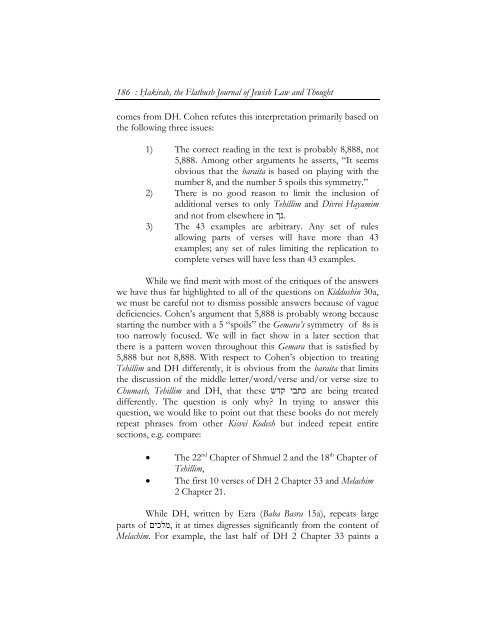Symmetrically Designed Sifrei Torah: A Quantitative Analysis - Hakirah
Symmetrically Designed Sifrei Torah: A Quantitative Analysis - Hakirah
Symmetrically Designed Sifrei Torah: A Quantitative Analysis - Hakirah
Create successful ePaper yourself
Turn your PDF publications into a flip-book with our unique Google optimized e-Paper software.
186 : Hạkirah, the Flatbush Journal of Jewish Law and Thought<br />
comes from DH. Cohen refutes this interpretation primarily based on<br />
the following three issues:<br />
1) The correct reading in the text is probably 8,888, not<br />
5,888. Among other arguments he asserts, “It seems<br />
obvious that the baraita is based on playing with the<br />
number 8, and the number 5 spoils this symmetry.”<br />
2) There is no good reason to limit the inclusion of<br />
additional verses to only Tehillim and Divrei Hayamim<br />
.נך and not from elsewhere in<br />
3) The 43 examples are arbitrary. Any set of rules<br />
allowing parts of verses will have more than 43<br />
examples; any set of rules limiting the replication to<br />
complete verses will have less than 43 examples.<br />
While we find merit with most of the critiques of the answers<br />
we have thus far highlighted to all of the questions on Kiddushin 30a,<br />
we must be careful not to dismiss possible answers because of vague<br />
deficiencies. Cohen’s argument that 5,888 is probably wrong because<br />
starting the number with a 5 “spoils” the Gemara’s symmetry of 8s is<br />
too narrowly focused. We will in fact show in a later section that<br />
there is a pattern woven throughout this Gemara that is satisfied by<br />
5,888 but not 8,888. With respect to Cohen’s objection to treating<br />
Tehillim and DH differently, it is obvious from the baraita that limits<br />
the discussion of the middle letter/word/verse and/or verse size to<br />
Chumash, Tehillim and DH, that these כתבי קדש are being treated<br />
differently. The question is only why? In trying to answer this<br />
question, we would like to point out that these books do not merely<br />
repeat phrases from other Kisvei Kodesh but indeed repeat entire<br />
sections, e.g. compare:<br />
• The 22 nd Chapter of Shmuel 2 and the 18 th Chapter of<br />
Tehillim,<br />
• The first 10 verses of DH 2 Chapter 33 and Melachim<br />
2 Chapter 21.<br />
While DH, written by Ezra (Baba Basra 15a), repeats large<br />
parts of ,מלכים it at times digresses significantly from the content of<br />
Melachim. For example, the last half of DH 2 Chapter 33 paints a
















